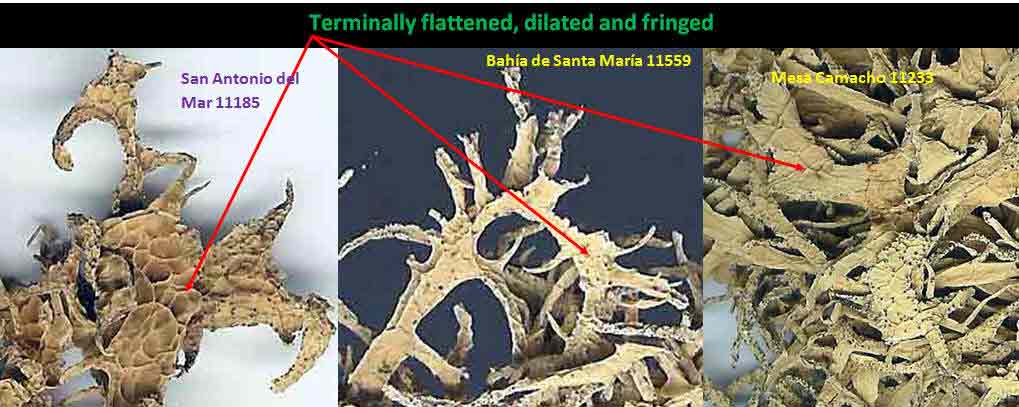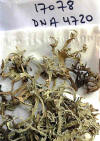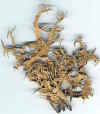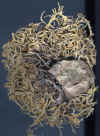Niebla effusa
is a species of fruticose lichen endemic to the peninsula of Baja California, occurring
along the Pacific Coast from near Punta Santo Domingo north to
Colonet. The species is recognized by the intricately interwoven rigid prismatic
branches with linear and flattened parts at various intervals that are
more conspicuously dilated and arched near apex where appearing also
short secund branchlets, and by containing salazinic acid without
triterpenes. Additional lichen substances of fumaroprotocetric acid
or a depside, which are rare chemotype combinations with salazinic acid,
are also recognized to be variation of this species that may
represent hybrids.
Related salazinic acid species, which often occur with
N. effusa, are
Niebla josecuervoi
distinguished having longer comb-like branchlets more near base than
apex, and Niebla arenaria
that differs by
terminal antler-like branchlets.
Niebla flabellata, which
is found more on rock faces and small stones along beaches,
differs in the smaller brittle thallus having tufts of basal branches
mostly flattened throughout. Also its
dilated parts appear more irregular in occurrence from base to near apex,
and more torn or lacerated along margins rather than branch-like.
Niebla effusa is a dominant lichen of terricolous lichen communities,
constituting much of the ground cover in a transitional
coastal chaparral scrub on mesas between Colonet and Punta Baja.
Associated terricolous species include N. arenaria,
N.
josecuervoi, N. juncosa var. spinulifera,
N.
palmeri, and N. pulchribarbara. The latter two are relatively
rare, and distinguished by their secondary metabolites, sekikaic
acid, and protocetraric acid, respectively, in contrast to salazinic
acid in N. effusa. In this region, Niebla species
seem to grow more on soil than rock because of the strong coastal wind
as evident by the wind-swept appearance of the vascular flora.
The terricolous lichen community is in further contrast to the rock
dwellers of the California chaparral and to the boulder and pebble
Niebla communities further south, and to the sporadic occurrences of
sand Niebla species found along bays, near beaches and on mesas.
Although Niebla effusa often occurs with N. arenaria,
it extends further inland in contrast to N. arenaria
often found more along beaches. Another salazinic acid species,
Niebla josecuervoi grows more on rocks than
on soil.
Niebla effusa
may prove to be the largest lichen on the planet in terms of weight and size.
Not only can it spread on the ground more than 1 m in diameter but it
may weigh more than 1
kg. An example of its size is shown in Spjut (1996, Plate 4C).
Species of Usnea, and other pendant lichens that may drape more than 1 m from tree
branches do not produce the weight found in species of
Niebla. This judgment is based on collecting samples of numerous
species across the U.S., and Baja California for antitumor and anti-HIV
screening. Niebla effusa attains its large size by its basal
branches not always being confined to a holdfast; they also creep
along
the surface rather than grow upright.
Niebla effusa is not a tumble (“vagrant”) lichen—one that moves about as result
of being
taken up by the wind—as implied by Bowler and Marsh (2004), in contrast to
N. arenaria and
N. limicola that often grow
loosely on sand near beaches where there is less vegetation and where
they can be more easily dislodged by wind. Occasional saxicolous variants of N. effusa
are recognized to arise from a
holdfast, or develop on rock as shown above; however, they may later
spread beyond the rock (also evident in the same photo); these seem to
occur more in the southern part of the range in Baja California.
DNA phylogeny did not separate phenotypic N. effusa from other
related species; yet, five specimens identified by this name represented
three species according to discrimination by BPP, in contrast to
four species for five specimens of N. josecuervoi (Spjut et al.
2020). A total of nine species were discriminated by BPP for 30
specimens with depsidone chemotypes. Although the depsidone species
can be discriminated by statistical analyses of DNA sequences, defining
them by their morphology is problematic because they are not clearly
separated in the phylogeny except for three as related to their
occurrence at the type
locality, or nearby; these are the
N. spatulata species complex, N. limicola, and
N.
flabellata. Other depsidone species sampled near their type locality
besides N. effusa are N. josecuervoi, and
N. marinii.
Niebla effusa appears to hybridize frequently with N. palmeri
and N. juncosa. Their phylogeny may appear in any of the three
chemotype clades. Niebla pulchribarbara is also suggested
because protocetraric acid is relatively rare, the chemotype for
the species.
For more discussion
and reference materials see Introduction to Niebla


























